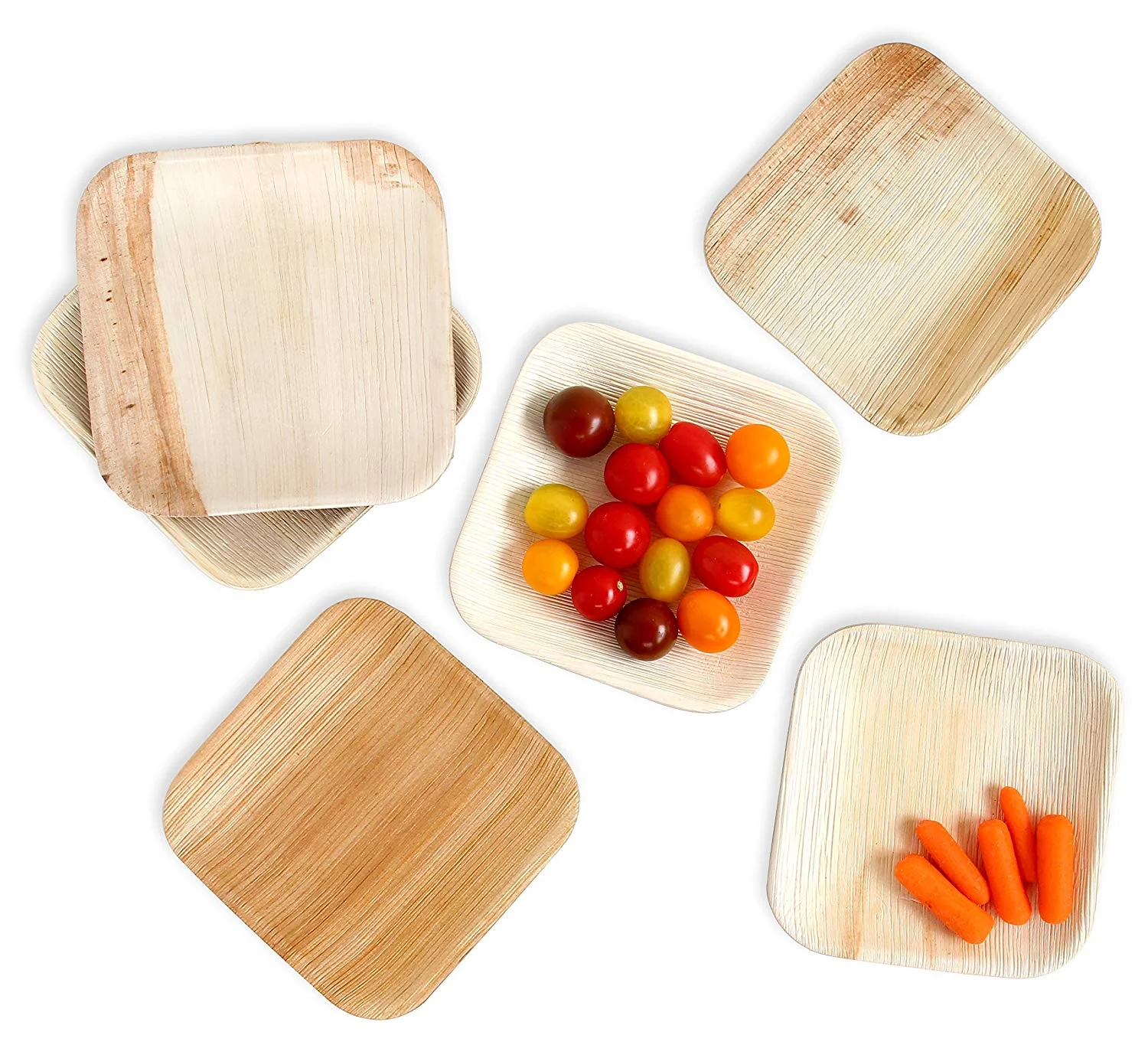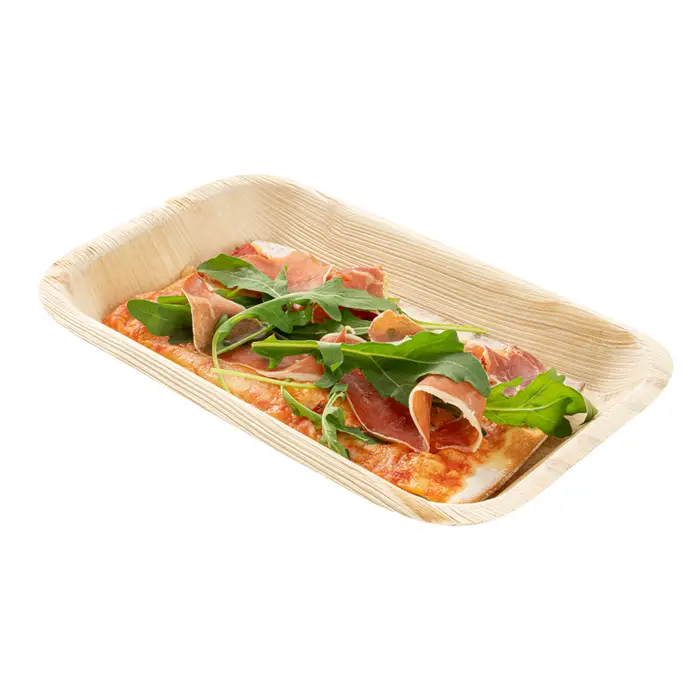In the realm of eco-friendly alternatives, palm leaf plates have emerged as a sustainable solution with a profound impact on both environmental conservation and user experience. These biodegradable plates, crafted from naturally fallen palm leaves, are transforming dining experiences across the globe. Let’s delve deeper into the remarkable user experience offered by these innovative plates.
The Origin Story of Palm Leaf Plates
Palm leaf plates have a fascinating origin story deeply rooted in sustainability and tradition. Originating from South Asia, particularly in countries like India, these plates stem from the indigenous practice of using naturally fallen palm leaves for various purposes, including serving food.
The process of creating palm leaf plates begins with the collection of fallen palm leaves from the Areca Palm tree. These leaves are gathered from the forest floors or sourced from palm plantations, ensuring no harm is caused to the trees. The leaves used for making these plates are typically the ones that naturally fall as part of the tree’s lifecycle, ensuring an eco-friendly and sustainable process.
Once collected, the palm leaves undergo a meticulous cleaning process to remove any impurities and dirt. This cleaning stage is crucial to ensure the plates are hygienic and safe for serving food. After cleaning, the leaves are then sun-dried to remove excess moisture and to enhance their natural strength and durability.
The artisans or craftsmen adept in the traditional art of making palm leaf plates skillfully shape the dried leaves into various plate sizes and shapes. This is done by carefully pressing the leaves using heat and pressure, without the use of any chemicals or additives. The plates are often crafted into elegant designs, retaining the natural texture and patterns of the palm leaves.
The making of palm leaf plates is not just a process; it’s a cultural tradition passed down through generations in certain communities. It holds significance in various cultural and religious practices, symbolizing a deep connection with nature and sustainable living. These plates are often used in ceremonies, festivals, and important gatherings, signifying respect for nature’s gifts.
What makes the origin of palm leaf plates remarkable is the blend of sustainability, craftsmanship, and cultural heritage. From the humble fallen leaves to beautifully crafted plates, this eco-friendly alternative reflects a harmonious relationship between tradition, nature, and modern-day sustainability practices.
Unveiling the Unique Characteristics
- Natural and Eco-Friendly: Derived from fallen Areca Palm leaves, these plates are completely natural and biodegradable. Their production involves no chemicals or additives, making them an environmentally conscious choice.
- Sturdiness and Durability: Despite their lightweight nature, palm leaf plates are incredibly sturdy. They can withstand various temperatures, making them suitable for both hot and cold dishes.
- Aesthetic Appeal: Each plate boasts a unique texture and pattern inherent to the palm leaves, adding a touch of natural beauty to dining experiences.
- Versatility: Palm leaf plates come in various shapes and sizes, catering to different culinary needs. They are suitable for diverse occasions, from casual gatherings to formal events.
- Heat Resistance: These plates handle heat remarkably well, making them microwave-safe and perfect for reheating food.
- Leak-Proof and Non-Toxic: Palm leaf plates don’t leak or impart any flavors to the food served on them. They are non-toxic and ideal for serving all kinds of dishes.
- Biodegradability: Once disposed of, these plates decompose naturally within a short span, enriching the soil without leaving any harmful residues.
- Cultural Significance: Beyond their practicality, palm leaf plates hold cultural significance in various traditions and ceremonies, symbolizing a connection with nature and sustainable living practices.
In essence, the unique characteristics of palm leaf plates encapsulate a perfect blend of functionality, sustainability, and cultural heritage, offering a remarkable dining experience while promoting environmental consciousness.
Embracing Sustainability in Dining Practices
- Reducing Waste: Opting for palm leaf plates promotes a reduction in plastic and foam waste. Unlike disposable plastic or styrofoam plates, palm leaf plates decompose naturally, lessening the burden on landfills.
- Eco-Friendly Production: The production process of palm leaf plates involves gathering fallen leaves without harming trees. This sustainable approach minimizes the environmental impact and supports a circular economy.
- Promoting Biodegradability: Palm leaf plates are biodegradable, breaking down organically and returning nutrients to the soil. They don’t leave behind harmful residues, making them a sustainable choice for minimizing environmental pollution.
- Conserving Resources: By utilizing natural resources like fallen palm leaves, these plates promote resource conservation. They minimize the need for synthetic materials and encourage the use of renewable resources.
- Cultural Preservation: Incorporating palm leaf plates in dining practices helps preserve cultural traditions associated with eco-friendly living. It honors ancient practices while embracing modern sustainability.
- Raising Awareness: Embracing palm leaf plates in dining experiences raises awareness about sustainable alternatives. It encourages others to make informed choices, contributing to a larger movement towards eco-conscious living.
- Supporting Sustainable Industries: By choosing palm leaf plates, consumers support industries that prioritize sustainability. This encourages further innovation and development of eco-friendly products.
In essence, embracing sustainability in dining practices through the adoption of palm leaf plates is more than just a choice—it’s a conscious effort to reduce environmental impact, support sustainable industries, and preserve cultural practices while enjoying a remarkable dining experience.
Versatility and Adaptability in Usage
- Diverse Occasions: Palm leaf plates seamlessly adapt to different occasions, from casual picnics to formal events. Their range of sizes and shapes caters to diverse dining needs, adding a touch of natural elegance to any setting.
- Catering Services: These plates are a preferred choice for catering services due to their aesthetic appeal and practicality. They offer a sustainable and visually appealing way to serve a wide array of cuisines.
- Restaurant and Food Industry: Palm leaf plates find applications in restaurants and the food industry, elevating the presentation of dishes while aligning with sustainable dining practices.
- Outdoor Events: Their durability and heat resistance make palm leaf plates ideal for outdoor events. They withstand varying temperatures and serve as a convenient, eco-friendly option.
- Home Use: At home, these plates offer convenience without compromising on style. Whether for everyday meals or special occasions, they complement diverse dining needs.
- Takeaways and Food Trucks: Palm leaf plates are also suitable for takeaways and food trucks, offering a sustainable packaging option that aligns with eco-friendly values.
- Special Occasions: Their cultural significance extends to special occasions and celebrations, adding a touch of tradition and sustainability to weddings, parties, and festivals.
- Art and Craft: Beyond dining, these versatile plates serve as a canvas for creative expressions in art and craft projects, showcasing their adaptability beyond their primary use.
In summary, the versatility and adaptability of palm leaf plates extend far beyond mere dining utility. They seamlessly integrate into various settings, offering a sustainable, aesthetic, and functional solution for diverse usage scenarios.
Elevating Culinary Experiences
- Aesthetic Appeal: Their natural textures and patterns enhance the visual presentation of dishes, creating an inviting and rustic charm on the dining table.
- Enhanced Dining Atmosphere: Using palm leaf plates transforms the dining experience, adding an eco-friendly ambiance that aligns with sustainability values, contributing to a more enjoyable mealtime.
- Promoting Sustainability: Their eco-conscious nature sparks conversations around sustainability, enriching the dining experience by fostering awareness and appreciation for environmentally-friendly choices.
- Accentuating Food Presentation: The plates’ unique textures complement various cuisines, enhancing the presentation of dishes and elevating the overall dining aesthetic.
- Connection with Nature: Dining with palm leaf plates offers a connection to nature, reminding individuals of the importance of preserving the environment while enjoying a meal.
- Cultural Significance: Incorporating these plates in dining experiences adds cultural depth and significance, honoring traditions associated with sustainable living.
- Versatility for Different Cuisines: Palm leaf plates accommodate various cuisines, from casual meals to elaborate spreads, enhancing the overall dining experience regardless of the type of food served.
- Memorable Dining Moments: Using these plates creates memorable dining moments, making meals more than just a culinary experience but also a conscious, sustainable choice.
In essence, palm leaf plates contribute significantly to elevating culinary experiences by infusing sustainability, aesthetics, cultural value, and a connection to nature into the act of dining, making every meal a remarkable and conscious experience.
User Feedback
1.Using palm leaf plates has been a game-changer for our events! Not only do they look fantastic with their natural textures, but they’re also sturdy enough to handle a variety of foods, including hot dishes. The fact that they’re eco-friendly adds a whole new level of satisfaction to our dining experience. Highly recommend them for anyone looking to elevate their events while staying environmentally conscious!
2.I’ve been using palm leaf plates for a while now, and I’m truly impressed. They’re not only aesthetically pleasing but also incredibly practical. They hold up well with both hot and cold foods, and I love that they’re compostable, making cleanup hassle-free. It’s a relief knowing I can host gatherings without worrying about the environmental impact of disposable plates. Definitely sticking with these eco-friendly options!
The Importance of User Feedback
User feedback holds immense importance as it serves as a vital tool for businesses and consumers alike, impacting product development, customer satisfaction, and overall market perception.
- Product Improvement: User feedback provides valuable insights into the strengths and weaknesses of a product. This information aids companies in refining their offerings, addressing issues, and enhancing product features to better meet consumer needs.
- Customer Satisfaction: Listening to user feedback demonstrates a company’s commitment to its customers. Addressing concerns or implementing suggestions can significantly improve customer satisfaction, fostering loyalty and positive relationships.
- Market Perception: Positive user feedback acts as a testament to the quality and value of a product. It influences the perception of potential customers, serving as a powerful endorsement and attracting new buyers.
- Identifying Trends and Patterns: Analyzing feedback helps identify recurring themes or patterns, enabling businesses to recognize emerging trends, preferences, and areas for innovation within the market.
- Enhanced Decision-Making: User feedback serves as a valuable source of data for informed decision-making. It guides businesses in setting priorities, allocating resources, and making strategic choices aligned with consumer needs.
- Building Trust and Credibility: Transparently incorporating user feedback demonstrates a commitment to transparency and improvement. This builds trust with consumers, showcasing a willingness to listen and adapt based on their experiences.
- Continuous Improvement: The iterative process of collecting and implementing user feedback fosters a culture of continuous improvement, driving innovation and ensuring products evolve to remain competitive.
In essence, user feedback serves as a cornerstone for businesses, driving product enhancements, fostering customer satisfaction, shaping market perception, and facilitating a dynamic and responsive approach to meeting consumer demands.
Conclusion: Redefining Sustainability and Quality
In conclusion, the user experience of palm leaf plates transcends mere functionality; it embodies a synergy of sustainability, versatility, and aesthetic appeal. These plates not only fulfill the need for eco-conscious dining but also elevate the overall experience, setting a new standard in sustainable tableware.
In essence, embracing palm leaf plates is not just a choice for eco-conscious individuals; it’s a celebration of innovative design, functionality, and a commitment to a greener future.
Remember, the user experience with these plates extends beyond the tangible; it’s about embracing a lifestyle that harmonizes with nature without compromising on quality or convenience.
















I am genuinely thankful to the owner of this website who has
shared this enormous paragraph at here.
Keep on writing, great job!
Excellent post. I used to be checking continuously this
blog and I’m inspired! Very useful information specially the last phase 🙂 I deal with such info much.
I used to be looking for this certain information for a long time.
Thank you and best of luck.
That is a very good tip especially to those fresh to the blogosphere.
Simple but very accurate info… Thank you for sharing this one.
A must read post!
Hello there! I simply wish to give you a big thumbs up for the excellent info you’ve got here on this post.
I will be coming back to your blog for more soon.